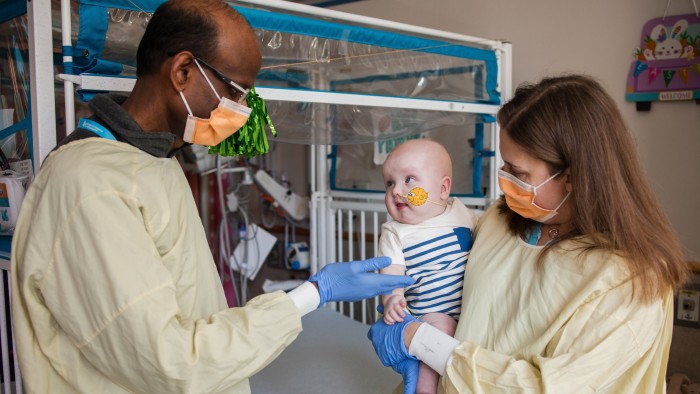Unlock the Editor’s Digest for free
Roula Khalaf, Editor of the FT, selects her favourite stories in this weekly newsletter.
Scientists in the US have performed the first personalised gene therapy on a child with a life-threatening rare disease, raising the prospect of similar bespoke treatments for many other disorders.
Researchers and clinicians in Pennsylvania used Crispr gene editing technology to correct a liver cell mutation in the six-month old, who quickly showed signs of better health.
The results highlight the potential of gene-focused “precision medicine” to treat people with uncommon conditions, for which drugs either don’t exist or can create life-long dependency.
“We hope that other academic investigators will replicate this method for many rare diseases and give many patients a fair shot at living a healthy life,” said Kiran Musunuru, co-author of a paper on the research published on Thursday in The New England Journal of Medicine. Gene therapy was ‘‘going to utterly transform the way we approach medicine”, he added.
The breakthrough resulted from a collaboration between the University of Pennsylvania and Children’s Hospital of Philadelphia. Musunuru, a professor at the university, and Rebecca Ahrens-Nicklas, who holds positions at both institutions, decided to focus on urea cycle disorders.
Sufferers lack a biological catalyst in the liver called an enzyme that helps convert ammonia, a waste product from digesting proteins, into urea for safe excretion as urine. This means the ammonia can build up to toxic levels, damaging organs such as the liver and brain.
The scientists worked with a boy known as KJ born last year with a urea cycle disorder. This would normally be treated with a liver transplant, with risks such as bleeding from surgery, infection and rejection of the replacement organ by the body.
The researchers developed a potential gene therapy, tested it in animals, won regulatory approval and administered a first dose before the infant was seven months old.
KJ soon showed signs of being able to eat and fight off infections in ways he could not have done without treatment. He was able to take in more proteins and recover from a cold and a gastrointestinal infection.
“While KJ will need to be monitored carefully for the rest of his life, our initial findings are quite promising,” Ahrens-Nicklas said.
The research highlights the fast-evolving field of medicine using Crispr-Cas9, the technology dubbed “genetic scissors”. Its developers Emmanuelle Charpentier and Jennifer Doudna won the Nobel Prize for chemistry in 2020.
In 2023, a gene editing therapy that targets the blood disorders sickle cell disease and beta thalassaemia became the world’s first Crispr treatment to win regulatory approval. Personalised therapies are expensive to develop, although they may save a lifetime of treatment costs.
The Pennsylvania treatment was a “unique case, a successful proof of concept, designed and applied in record time”, said Gemma Marfany, a genetics professor at the University of Barcelona who was not involved in the research.
“It seems to me to be a scientific ‘miracle’ that has made it possible to cure a very rare severe disease, and provides knowledge to treat many other diseases,” she said.
The therapy was complex and would need more work to expand it to other cases, said Marc Güell, professor at Spain’s Pompeu Fabra university. Other tissues would be harder to edit than the liver, he warned.
But the treatment was a “great demonstration”, he said. “Individualised, tailor-made therapies for a single patient are no longer a dream.’’




